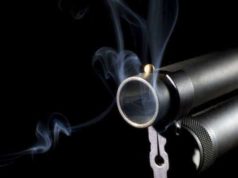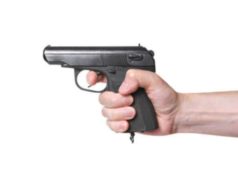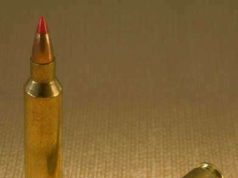
Everyone knows that firearms have the potential be extremely dangerous. After all, firearms are weapons that, at the nature of their design, can kill and at the very least injure a human being. However, it is important to keep in mind that firearms are created with the purpose of protection. Every person that owns a firearm must have the necessary training in order to prevent any potentially harmful or fatal accidents to him/herself or others.
Gun Safety is the first thing that is enforced to anyone handling weapons or firearms. Whether the person is a novice and learning how to shoot for the first time, or a seasoned veteran, Gun Safety is always the most important concept that must be stressed and applied whenever handling a firearm.
Gun Safety methods can seem to be fairly simple: anyone that possesses a basic concept of logic can handle a firearm safely. This may be a common misconception to most because the slightest oversight has been proven time and again to be potentially fatal. Although a basic application of knowledge of guns may be the basis behind Gun Safety, there are aspects of handling a firearm–especially for the first time–that must be stressed and properly instructed in order to provide for a safe environment when handling a gun.
There are many organizations that have their own basic gun safety rules and regulations, and many of them are very similar. The government itself imposes several gun safety rules by providing for Federal and State rules and regulations, but they are concerned at a much more specific aspect, such as legal possession, purchasing, and carrying of firearms.
The laws are sometimes extremely complex, that even today people are unsure as to legal comprehension in instated laws. Much of the confusion arises from the different firearm laws employed state by state, such as eligibility for gun licenses, which states require gun licenses, gun licenses to purchase, own, or carry, etc. However, for the purpose of basic gun safety, the practical aspects of handling and shooting are discussed and are the area of focus. As mentioned, there are many organizations that can provide basic gun safety literature to interested parties. One of these organizations is the National Rifle Association.
The NRA is one of the most recognizable and, quite possibly, the foremost authority mentioned when the subject of firearms is being discussed. Jeff Cooper, a firearms expert, also developed some basic rules for gun safety. Cooper developed what is popularly known as “The Four Rules,” which he created to lengthen the previous “three basic rules” and simplify other organization’s more complex safety guidelines.
Cooper’s Four Rules are:
All guns are always loaded.
Never let the muzzle cover anything you are not willing to destroy.
Keep your finger off the trigger until your sights on the target.
Be sure of your target and what is beyond it.
Cooper’s rules are often compiled by other organizations and interpreted in their own way, but the key introduction of the first rule is unique because in having the mindset that a firearm is always loaded–regardless if that is a true fact–people will mentally assume more care when handling the weapon. An association that has provided similar instruction and did not introduce Cooper’s first rule beforehand is the NRA.
Though their basic gun safety rules do not assume the gun is always loaded, they are similar and just as effective. As per the National Rifle Association, there are three fundamental or basic rules that a person must follow for the appropriate and safe handling of a firearm:
Always keep the weapon pointed in a safe direction. The most basic and logical rule of them all. The front end of the firearm must always be pointed in a direction that, if discharged intentionally or by mistake, no person would potentially harmed. It simply the employment of common sense.
Always keep your finger off the trigger until absolutely prepared to fire. This simple action can prevent accidental discharging of the weapon. Any thing can happen for individual to squeeze the trigger accidentally or before prepared to shoot. Resting the trigger on the side of the gun or on the trigger guard is the best place to keep the finger until ready to shoot.
Always keep the gun unloaded until the moment that the weapon is to be discharged. Again, common sense proves to be at hand; if the gun is not loaded, and no round is chambered, the weapon can not cause harm if the trigger is engaged. It also important to secure the safety device whenever handling a gun, and disengage only until the very moment that weapon is to be fired. In instances where the gun has a magazine, remove it promptly to make sure that the chamber is clear of ammunition. If not completely sure, have the weapon inspected by someone qualified to handle it and let them properly inspect it before use.
The NRA also expands on these basic rules to include extra provisions to exercise caution:
Know what your target is and what its surroundings are.
Know how to use the gun safely; learn how the gun operates.
Be sure the gun is safe to operate.
Use only the specified type of ammunition for the weapon.
The use of protective eye wear and ear protection is strongly encouraged.
Never use alcohol, illegal drugs, or controlled substances while handling a gun.
Store guns in a way that any person unauthorized to use one may not gain access.
Be aware of other specific guidelines regarding types of firearms and shooting activities.
Clean the weapon regularly to ensure its safe use for subsequent occasions.
These extra guidelines may also expand on their basic premises to fully explain at detail the procedure for observing that rule. However, at their most basic, they still offer a great understanding as to how to handle a firearm safely.
Gun Safety is the foremost thing to observe while handling any kind of firearm. It is the most basic step that is always taught by qualified instructors and professionals, and should be observed by anyone actively participating in the actual shooting of a firearm, as well as any by-standers or observers that may be engaged as well. Gun Safety may be the simple use of common sense, but in outlining specific rules to followed, it ensures that guns and firearms are dangerous and must be treated with respect and care.
























